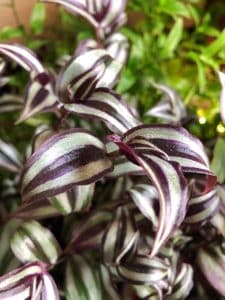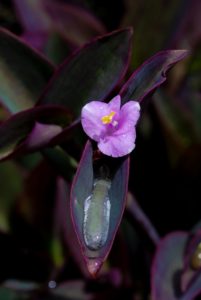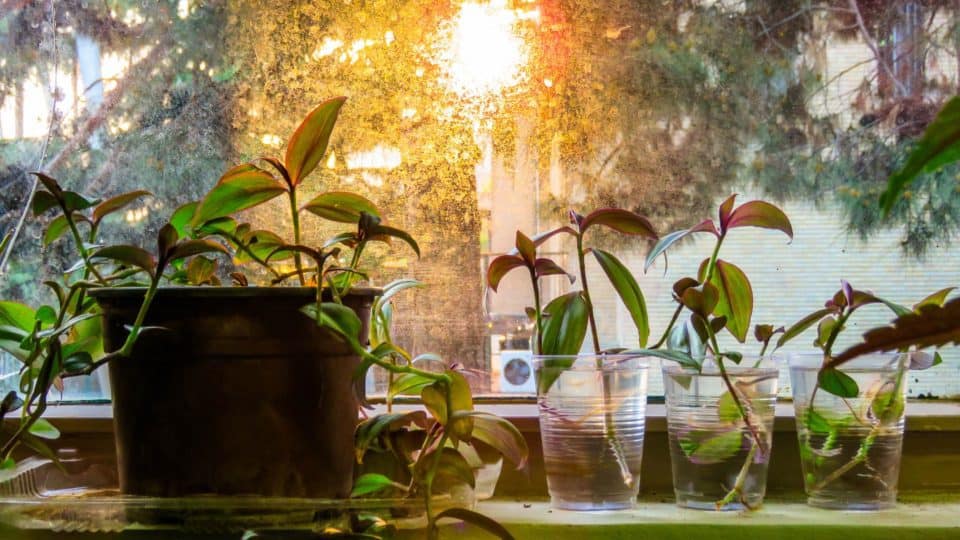Some links in the post are affiliate links and I get a commission from purchases made through some links found in the post.
The Wandering Jew plant- why is it called this? There has been a lot of debate as to whether people should continue using the Wandering Jew as the identifier for the Tradescantia Zebrina plant.
Some people find this name harmless, while others feel that it has an offensive history. This is relating to a mythical story where a Jew was condemned to wander the Earth until the apocalypse.
The name also resurfaced in the 20th century during the Nazi period.
Given the history of this name and the likelihood of causing offence, it might be necessary to consider naming this plant with another identifier over time.
Alternatively, people may seek to stick to its scientific name- Tradescantia Zebrina.
The Tradescantia Zebrina plant is not like most household plants in that it is much easier to grow and does not have the standard plain look.
Instead, it features beautiful patterns on its leaves and stems, making it quite a sight to behold.
It looks better when bushy, but some growing conditions may make the wandering jew plant leggy, which is a problem we will delve into today. Let’s get started:
Why is your Wandering Jew Plant Leggy?
One thing to note about the Tradescantia Zebrina plant is that it grows at a very fast rate.
You might want to consider buying bigger pots in advance because you will repot it quite a few times.
The wandering jew plant looks better when bushy but sometimes it may have leggy growth.
Poor Lighting
Often, this legginess shows during the winter months when the plant is in its dormant stage.
But you can always solve this by ensuring that the plant gets enough light even when the months get colder and darker.
All you need to do is adjust the position of the plant and move it to a better lit area or invest in a grow light.
So, how much light should your plant be getting? This plant is picky about how much light it gets and will do well in indirect sunlight but bright light.
Usually, this is very confusing because people think that if a plant needs bright light, this equates to a need for exposure to the full sun.
But this is not the case. Instead, you need to place your plant in an area that has access to light but not direct exposure to sun rays.
You can easily achieve this by using blinds in lit areas. It even gets more confusing with the Wandering Jew plants.
If you have a purple plant, you will need to place it in full sun. Other varieties will burn in this kind of exposure but a purple plant will do better in these conditions.
You are better off placing your plant towards a West or east-facing window to allow it to access bright light in the morning and during the day without full exposure at any point.
If you want to grow your plant outside, make sure that you shade it by placing it in an area that does not have access to the hot afternoon sun.
Why is my Wandering Jew Growing Straight Up?
If your plant seems to be heading to the sky, poor lighting is the Likely problem.
You will need to ensure that your plant is getting enough bright light without full exposure to the sun.
Poor Watering
 If the wandering jew plant does not have access to enough moisture in the soil, it can appear leggy. This problem is common in the winter where most people tend to cut back on watering.
If the wandering jew plant does not have access to enough moisture in the soil, it can appear leggy. This problem is common in the winter where most people tend to cut back on watering.
Wondering Jews love regular watering and will not do well if the soil stays dry for too long.
Even so, you should be careful not to overwater the plant as this can lead to root rot which can kill the plant.
It’s important that you find a balance between giving the plant more than it needs and less than it needs.
On the same note, you must also adjust the watering techniques over the year such that you give the plant less water during the colder months.
At this time, the plant will be getting into the dormant stage and will not need much water to survive this stage. Giving the plant a lot of water at this time can increase the chances of root rot.
It can be hard to tell when to water the plant. The best way to do this is to check the state of the soil.
If the soil appears dry at least 2 inches below the soil surface, you can water the plant.
During the summer, you will want to keep the soil moist by watering the soil thoroughly and allowing the excess water to drain from the bottom of the pot.
The soil should remain damp but not wet. During winter, you will need to space out the watering even more by checking the state of the soil about 2 inches below the soil surface.
If it appears dry, moisten it but don’t try to wet it like you would in the summer.
If you have trouble telling how much water is in the soil, you can invest in a moisture gauge.
Low Humidity
This is another problem that will come about in the winter where humidity levels tend to drop drastically especially in the indoors.
Low humidity not only affects the legginess of the plant but it also affects the leaves such that they start turning brown and dying.
During the winter, you can place the plant in the kitchen or bathroom where the humidity levels tend to be higher.
Alternatively, you can invest in a humidifier which you can place near the plant.
For a low-cost solution, you can place the plant pot on a tray filled with pebbles and water, ensuring that the plant part does not absorb the water and pave the way for root rot.
If you’re enjoying this article, check out our article on how to fix a leggy pilea.
How do you Fix a Leggy Wandering Jew Plant?
Most people fix a leggy wandering jew plant with legginess by pinching off the new stems. This method works with the usual legginess.
Once you pinch off the stems, the plant reciprocates by developing two new stems which create a bushy look.
However, if the legginess owes to poor lighting, low humidity, or poor watering techniques, you will find yourself pruning the plant more than is necessary.
In this case, you would be better of addressing the cause of the problem and reducing the maintenance needs for the plant.
Other Problems with Your Wandering Jew Plant
Your plant may also exhibit other signs of poor growing conditions as follows:
Why are your Wandering Jew Leaves Turning Yellow?
Yellowing leaves are a sign that your plant is not getting water as per its requirements.
You can either be over-watering or under-watering your plants and you will need to check the moisture levels in the soil and adjust your watering schedule.
The plant does well in soil that is neither dry nor soggy. You need to dig at least two inches into the soil to assess how dry it is.
If it feels dry, you can thoroughly wet it during the summer, and ensure that the excess water drains, leaving the soil damp.
During winter, you will not wet it as much but will need to ensure that the soil is not dry by dampening it.
Your potting soil could also be to blame. If you use a mix that is not suited for indoor growing requirements, it will not retain water or will retain too much water.
The plant can either suffer root rot or can lack enough water to enable the roots to absorb nutrients from the potting mix.
You will need to look into the potting soil as well as your watering techniques to diagnose the cause of the problem.
If you find that your watering techniques are not suitable, you may want to consider buying a moisture gauge.
Why are your Wandering Jew Leaves Curling?
Like we earlier stated, access to full sun is not good for a Wandering Jew plant.
Direct sunlight causes leaves to curl around the edges such that the plant will not appear as lush as it should be.
You will need to move the plant to an East or West facing window where it will have access to bright light but will not have exposure to the sun’s unfiltered rays.
The solution will not be to move it to a dark area because this can hamper its growth.
Why is your Wandering Jew Changing Color?
Once again, this problem owes to too much direct sunlight. If your plant is in direct sunlight, the leaves will fade, and you will notice a change in the color.
Unfortunately, this change is irreversible and you will have to make do with the new normal.
Luckily, you can prevent this from happening to the new growth by moving the plant to a brightly lit area without access to full sun exposure.
With the Wandering Jew or any other plant, if you notice any issues, they likely result from poor growing conditions.
The way to deal with these is to assess whether the plant is growing in the required conditions and make changes where need be.
Final Thoughts: How do you Fix a Leggy Wandering Jew Plant?
 The Wandering Jew plant should be pretty easy to take care of once you monitor its lighting, watering and humidity needs.
The Wandering Jew plant should be pretty easy to take care of once you monitor its lighting, watering and humidity needs.
As long as you prune the plant regularly, the vines should grow healthy and thick.
Also, trim the plant often to encourage new growth during the summer and spring months to make the plant even bushier. Pruning can take place at any time.
Happy Gardening!
Before you go, here are some more related articles I encourage you to read below to help solve more of your gardening issues:
How to fix your schefflera plant problems.
Written by: Daisy Njeri

